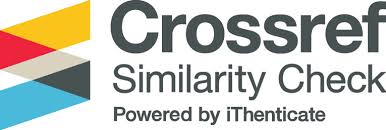Correlation Of Side-Effects With Length Of Stay (LOS) In Coronary Heart Patients In Hospital ‘X”
Abstract
Coronary heart disease (CHD) is caused by the narrowing and blockage of blood vessels that carry blood to the heart. CHD is listed as the highest deadly disease by WHO. CHD treatment is carried out long-term and uses a combination of several drugs, so there is a risk of drug side effects. Length of stay (LOS) is one indicator of successful therapy for CHD patients. However, no correlation studies of LOS with the incidence of drug side effects in CHD patients. Therefore, the purpose of the study was to analyze the potential side effects that occur in CHD therapy and to find the relationship with LOS in the "X" Hospital in Surakarta in 2021.
This research uses a descriptive observational method by retrospectively taking patient medical record data that match the inclusion criteria. The sample in this study was 81 patients whose results were tabulated and analyzed univariately by describing the results based on the percentage of events. The reference in this study was Meyler's Side Effects of Drugs guidelines and several supporting journals. To find the relationship between the incidence of drug side effects with LOS using SPSS with the chi-square test. The result show that 23 patients (28%) had the incidence of side effects from CHD treatment. Potential side effects arising in patients include muscle pain; weakness; fever; diarrhea; dizziness; constipation; and nausea-vomiting; are 43.48%, 26.09%, 13.04%, 4.35%, 4.35%, 4.35%, 4.35%, respectively. There was no correlation between side effects and LOS (p=0.803; OR=1,132).References
[2] WHO, “The top 10 causes of death,” 2020. https://www.who.int/news-room/fact-sheets/detail/the-top-10-causes-of-death.
[3] PERKI, Panduan praktik klinis (ppk) dan clinical pathway (cp) penyakit jantung dan pembuluh darah. 2016.
[4] Kemenkes RI, “Situasi kesehatan jantung,” Pus. data dan Inf. Kementeri. Kesehat. RI, p. 3, 2014, doi: 10.1017/CBO9781107415324.004.
[5] H. H. Mariyono and K. Suryana, “ADVERSE DRUG REACTION,” J. Chem. Inf. Model., vol. 53, no. 9, pp. 1689–1699, 2013.
[6] Michael and Z. M. Ramadhania, “Obat Penginduksi Perdarahan,” Farmaka, vol. 15, pp. 222–230, 2017.
[7] D. U. Rahmawati and N. Mutmainah, “Kajian Interaksi Obat Potensial Pada Pasien Penyakit Jantung Koroner Rawat Inap di RSUD Moewardi Tahun 2018,” pp. 417–428, 2021.
[8] M. F. Salim, I. K. Lubis, and Sugeng, “Perbedaan length of stay ( LoS ) Pasien Diabetes Mellitus Berdasarkan Komplikasi Pendahuluan Metode penelitian,” 2019.
[9] PERKI, “Pedoman Tatalaksana Sindrom Koroner Akut Edisi Ketiga,” 2015.
[10] D. Zahrawardani, K. S. Herlambang, and H. D. Anggraheny, “Analisis Faktor Risiko Kejadian Penyakit Jantung Koroner di RSUP Dr Kariadi Semarang TheAnalysis of Risk Factors of The Case of Coronary Heart Disease at RSUP Dr Kariadi Semarang Korespondensi :,” vol. 1, no. 2, pp. 13–20, 2013.
[11] L. Ghani, M. D. Susilawati, and H. Novriani, “Faktor Risiko Dominan Penyakit Jantung Koroner di Indonesia,” Bul. Penelit. Kesehat., vol. 44, no. 3, pp. 153–164, 2016, doi: 10.22435/bpk.v44i3.5436.153-164.
[12] R. Desky and B. Susanto, “HUBUNGAN FAKTOR RESIKO DENGAN ANGKA KEJADIAN PENYAKIT JANTUNG KORONER DI PUSKESMAS KOTA KUTACANE KECAMATAN BABUSALAM KABUPATEN ACEH TENGGARA TAHUN 2020,” vol. IV, no. Ii, pp. 83–89, 2021.
[13] P. Kumar and M. Clark, Clinical Medicine, Eighth. 2012.
[14] O. R. Torawoba, J. E. Nelwan, and A. Asrifuddin, “DIABETES MELITUS DAN PENYAKIT JANTUNG KORONER PADA PASIEN RAWAT JALAN RUMAH SAKIT,” vol. 10, no. 4, pp. 87–92, 2021.
[15] P. S. Nugroho, “HUBUNGAN DIABETES MELITUS DENGAN PENYAKIT JANTUNG KORONER (ANALISIS DATA BASELINE KOHORT PTM TAHUN 2011),” 2017.
[16] L. Marleni and A. Alhabib, “Faktor Risiko Penyakit Jantung Koroner di RSI SITI Khadijah Palembang,” J. Kesehat., vol. 8, no. 3, p. 478, 2017, doi: 10.26630/jk.v8i3.663.
[17] U. Ralapanawa et al., “Epidemiology and risk factors of patients with types of acute coronary syndrome presenting to a tertiary care hospital in Sri Lanka,” BMC Cardiovasc. Disord., vol. 19, no. 1, pp. 1–9, 2019, doi: 10.1186/s12872-019-1217-x.
[18] B. Williams et al., Interpretation of the 2018 ESC/ESH Guidelines for the Management of Arterial Hypertension, vol. 22, no. 21. 2019.
[19] WHO, MSH, and USAID, “Management Sciences for Health and World Health Organization,” Drug Ther. Comm. Train. Course, pp. 1–24, 2007, [Online]. Available: http://www.who.int/medicines/technical_briefing/tbs/04-PG_Dug-Safety_final-08.pdf?ua=1.
[20] PERKI, PEDOMAN TATALAKSANA DISLIPIDEMIA. 2013.
[21] UI, Farmakologi dan Terapi, 5th ed. Jakarta: Fakultas Kesehatan Universitas Indonesia, 2007.
[22] APhA, Drug Information Handbook, 21st ed. USA: Lexi-Comp Inc, 2012.
[23] D. Dutta, M. Fischler, and A. McClung, “Angiotensin converting enzyme inhibitor induced cough in Nigerians.,” West Afr. J. Med., vol. 20, no. 1, pp. 46–47, 2001.
[24] L. Taheri, A. Z. argha. Boroujeni, M. Kargar Jahromi, M. Charkhandaz, and M. Hojat, “Effect of streptokinase on reperfusion after acute myocardial infarction and its complications: an ex-post facto study,” Glob. J. Health Sci., vol. 7, no. 4, pp. 184–189, 2015, doi: 10.5539/gjhs.v7n4p184.
[25] M. Ghosh, K. K. Pulicherla, V. P. B. Rekha, G. Venkat Rao, and K. R. S. Sambasiva Rao, “A review on successive generations of streptokinase based thrombolytic agents,” Int. J. Pharm. Pharm. Sci., vol. 4, no. SUPPL.3, pp. 38–42, 2012.
[26] S. Y. Astuti, M. Ihsan, and F. Rahmawati, “Hubungan antara Drug-Related Problems dan Lama Rawat Inap pada Pasien dengan Diabetes Tipe 2,” J. Manaj. DAN PELAYANAN Farm. (Journal Manag. Pharm. Pract., vol. 10, no. 2, p. 77, 2020, doi: 10.22146/jmpf.43576.













